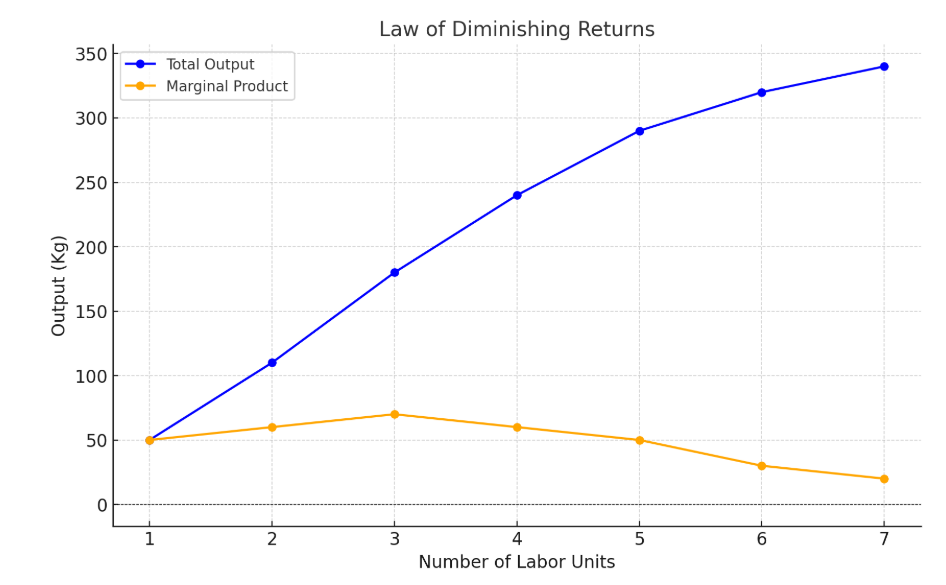
The Law of Diminishing Returns , also known as the principle of diminishing marginal productivity, is a fundamental concept in economics. It describes how, as additional units of a variable input are added to a fixed input, the marginal output derived from each additional unit of input eventually decreases, holding all other factors constant. This principle is pivotal in understanding production efficiency and resource allocation.
Law of Diminishing Returns Meaning
The law of diminishing returns states that in the short run, as more units of a variable factor (such as labor) are applied to a fixed factor (like land or machinery), the additional output produced by each new unit of the variable factor will start to decline after a certain point. This phenomenon arises due to the limitations imposed by the fixed factor, which restricts the productive capacity of the variable inputs. For example, consider a factory with a fixed number of machines. Initially, adding more workers increases total production as they operate the machines more efficiently. However, as the number of workers continues to increase, overcrowding occurs, and the contribution of each additional worker to total output diminishes.Law of Diminishing Returns Stages
The law operates in three distinct stages:Increasing Returns
In the initial phase, the addition of variable inputs leads to a more than proportional increase in output. This occurs due to better utilization of the fixed factor, specialization, and improved efficiency.Diminishing Returns
After a certain point, the marginal output of additional units of input begins to decline. While total output still increases, it does so at a decreasing rate. This marks the beginning of diminishing returns.Negative Returns
If variable inputs are continuously added beyond the optimal point, total output may start to decline. This stage reflects over-utilization of the fixed factor, resulting in inefficiencies.Law of Diminishing Returns Assumptions
To apply the law effectively, the following assumptions are made:Fixed Factors of Production
At least one factor of production, such as land or machinery, remains constant while the variable input (e.g., labor) increases.Homogeneous Inputs
All units of the variable input, like labor or raw materials, are of the same quality and skill level.Unchanged Technology
The level of technology used in production remains constant. Any technological improvement could offset diminishing returns.Short-Run Production
The law applies in the short run, where some factors of production are fixed and cannot be increased.Efficient Utilization of Resources
Resources are utilized efficiently, and diminishing returns occur solely due to the overuse of fixed inputs, not because of mismanagement.Divisibility of Inputs
The variable inputs can be divided into smaller units to measure incremental changes in output accurately.No Change in Output Prices
The prices of goods produced or inputs used do not fluctuate during the production process.Recommended Books: CBSE Class 11 Combo Set of 6 Books
Example with Tabular Representation
Consider a farm where a fixed piece of land (fixed input) is cultivated using varying amounts of labor (variable input). The table below illustrates how the law of diminishing returns works:| Example of Law of Diminishing Returns | ||
| Labor (Units) | Total Output (Kg) | Marginal Product (Kg) |
| 1 | 50 | 50 |
| 2 | 110 | 60 |
| 3 | 180 | 70 |
| 4 | 240 | 60 |
| 5 | 290 | 50 |
| 6 | 320 | 30 |
| 7 | 340 | 20 |
Explanation of the Table
- When one unit of labor is added, the total output is 50 kg, and the marginal product is also 50 kg.
- As the second unit of labor is added, the total output increases to 110 kg, and the marginal product rises to 60 kg. This is due to improved utilization of land.
- However, after the fourth unit of labor, the marginal product starts to decline (from 70 to 60 kg), as the land becomes overcrowded and less efficient.
- Eventually, the seventh unit of labor yields only 20 kg of additional output, highlighting the law of diminishing returns.
Graphical Representation
The law of diminishing returns can be visualized using a graph. It typically has: X-axis : Number of Labor Units Y-axis : Total Output and Marginal Product The graph above illustrates the law of diminishing returns:
The
Total Output curve
shows a steady increase initially, but the rate of increase slows down as more labor is added, reflecting diminishing returns.
The
Marginal Product curve
rises at first, reaches a peak, and then starts to decline as the additional units of labor contribute less and less to output.
The Law of Diminishing Returns is a critical economic principle that explains the limits of production efficiency when additional variable inputs are added to a fixed factor. While it highlights the challenges of resource allocation and productivity, understanding its implications can help businesses and policymakers make informed decisions. By recognizing the point of diminishing returns, organizations can optimize input utilization and maintain sustainable growth
Join
PW Commerce Online Course
now and excel in your academic and professional pursuits!
The graph above illustrates the law of diminishing returns:
The
Total Output curve
shows a steady increase initially, but the rate of increase slows down as more labor is added, reflecting diminishing returns.
The
Marginal Product curve
rises at first, reaches a peak, and then starts to decline as the additional units of labor contribute less and less to output.
The Law of Diminishing Returns is a critical economic principle that explains the limits of production efficiency when additional variable inputs are added to a fixed factor. While it highlights the challenges of resource allocation and productivity, understanding its implications can help businesses and policymakers make informed decisions. By recognizing the point of diminishing returns, organizations can optimize input utilization and maintain sustainable growth
Join
PW Commerce Online Course
now and excel in your academic and professional pursuits!
What is the Law of Diminishing Returns FAQs
What is the law of diminishing returns?
The law of diminishing returns states that when one factor of production (e.g., labor) is increased while other factors (e.g., land or capital) are held constant, the marginal output of the variable input will eventually decline after a certain point.
What causes diminishing returns in production?
Diminishing returns occur due to the inefficient utilization of fixed inputs when too many variable inputs are added. For example, overcrowding in a factory or excessive labor on limited land can reduce productivity.
How does the law of diminishing returns differ from economies of scale?
The law of diminishing returns focuses on the decline in marginal productivity when one input increases while others are fixed. Economies of scale, on the other hand, describe cost advantages achieved when production scales up, often reducing the average cost per unit.
Can diminishing returns lead to negative returns?
Yes, if variable inputs are continuously added beyond the optimal point, it can lead to a decrease in total output. For instance, excessive workers on a small piece of land might hinder productivity rather than increase it.
Why is the law of diminishing returns important in economics?
This law helps businesses and policymakers understand how to allocate resources efficiently. It ensures that inputs are not overused, thereby maintaining productivity and profitability while minimizing waste.
Talk to a counsellorHave doubts? Our support team will be happy to assist you!

Check out these Related Articles
Free Learning Resources
PW Books
Notes (Class 10-12)
PW Study Materials
Notes (Class 6-9)
Ncert Solutions
Govt Exams
Class 6th to 12th Online Courses
Govt Job Exams Courses
UPSC Coaching
Defence Exam Coaching
Gate Exam Coaching
Other Exams
Know about Physics Wallah
Physics Wallah is an Indian edtech platform that provides accessible & comprehensive learning experiences to students from Class 6th to postgraduate level. We also provide extensive NCERT solutions, sample paper, NEET, JEE Mains, BITSAT previous year papers & more such resources to students. Physics Wallah also caters to over 3.5 million registered students and over 78 lakh+ Youtube subscribers with 4.8 rating on its app.
We Stand Out because
We provide students with intensive courses with India’s qualified & experienced faculties & mentors. PW strives to make the learning experience comprehensive and accessible for students of all sections of society. We believe in empowering every single student who couldn't dream of a good career in engineering and medical field earlier.
Our Key Focus Areas
Physics Wallah's main focus is to make the learning experience as economical as possible for all students. With our affordable courses like Lakshya, Udaan and Arjuna and many others, we have been able to provide a platform for lakhs of aspirants. From providing Chemistry, Maths, Physics formula to giving e-books of eminent authors like RD Sharma, RS Aggarwal and Lakhmir Singh, PW focuses on every single student's need for preparation.
What Makes Us Different
Physics Wallah strives to develop a comprehensive pedagogical structure for students, where they get a state-of-the-art learning experience with study material and resources. Apart from catering students preparing for JEE Mains and NEET, PW also provides study material for each state board like Uttar Pradesh, Bihar, and others
Copyright © 2025 Physicswallah Limited All rights reserved.
Get App









